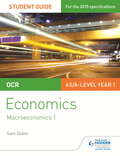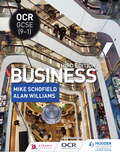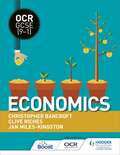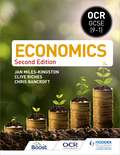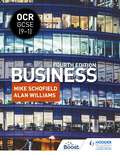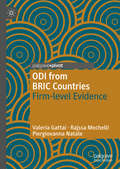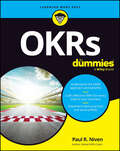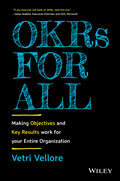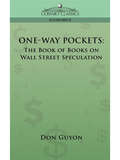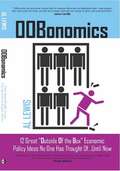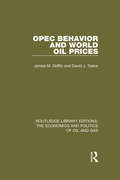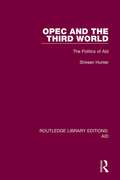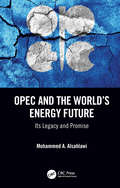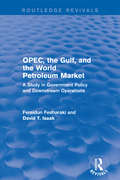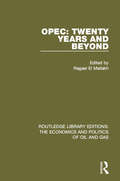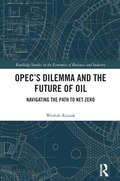- Table View
- List View
OCR Economics Student Guide 2: Macroeconomics 1
by Sam DobinExam Board: OCR Level: AS/A-level Subject: Economics First Teaching: September 2015 First Exam: Summer 2016Reinforce students' understanding throughout the course. Clear topic summaries with sample questions and answers will help to improve exam technique to achieve higher grades.Written by experienced teacher Sam Dobin, this Student Guide will help you to:- Identify key content with a concise summary of topics examined in the 2015 OCR A level Economics specification- Measure understanding with exam tips and knowledge-check questions, with answers at the end of the guide- Develop independent learning skills with content that can be used for further study and research- Improve exam technique with sample graded answers to exam-style questions
OCR GCSE (9-1) Business, Third Edition
by Alan Williams Mike SchofieldAn OCR endorsed textbookBuild strong knowledge and skills with this market-leading Student Book from OCR's Publishing Partner for GCSE Business; fully updated by subject experts for the 2017 specification, it provides comprehensive content coverage, engaging case studies and assessment activities.- Develops understanding of business concepts and theories through clear explanations, illustrated by diagrams and cartoons that help all learners access the content- Cements and extends subject knowledge with case studies that encourage students to think commercially about contemporary issues and contexts- Enables students to apply their learning and strengthen their investigative, analytical and evaluation skills as they progress through a range of activities- Prepares students for assessment with a variety of practice questions and handy tips for successfully answering different question types- Supports revision by summarising the learning outcomes, key terms and facts for each unit
OCR GCSE (9-1) Business, Third Edition
by Alan Williams Mike SchofieldExam Board: OCRLevel: GCSESubject: BusinessFirst Teaching: September 2017First Exam: June 2019An OCR endorsed textbookBuild strong knowledge and skills with this market-leading Student Book from OCR's Publishing Partner for GCSE Business; fully updated by subject experts for the 2017 specification, it provides comprehensive content coverage, engaging case studies and assessment activities.- Develops understanding of business concepts and theories through clear explanations, illustrated by diagrams and cartoons that help all learners access the content- Cements and extends subject knowledge with case studies that encourage students to think commercially about contemporary issues and contexts- Enables students to apply their learning and strengthen their investigative, analytical and evaluation skills as they progress through a range of activities- Prepares students for assessment with a variety of practice questions and handy tips for successfully answering different question types- Supports revision by summarising the learning outcomes, key terms and facts for each unit
OCR GCSE (9-1) Economics
by Christopher Bancroft Clive Riches Jan Miles-KingstonExam Board: OCRLevel: GCSESubject: EconomicsFirst Teaching: September 2017First Exam: June 2019Build students' knowledge of economics and understanding of its impact beyond the classroom with this new textbook, produced by the leading Economics publisher and OCR's publishing partner.- Develop knowledge with clear explanations in every chapter, end-of-chapter summaries and key terms highlighted for on-going revision- Understand economics in context with up-to-date examples of economic challenges on a local, national and global level- Extend your learning and develop critical skills with engaging stretch and challenge tasks- Prepare for exams with plenty of practice questions and activities that improve your critical thinking skills
OCR GCSE (9-1) Economics: Second Edition
by Christopher Bancroft Clive Riches Jan Miles-KingstonThis fully updated student textbook for OCR GCSE Economics will help you develop an understanding of the principles of economics and its impact outside the classroom. This new edition is specially designed to make economics accessible and help you tackle complex topics with confidence.- Includes new, up-to-date case studies to demonstrate how economic concepts can be applied in the real world- Highlights key terms throughout to increase your confidence and improve your essay-writing skills, with cross-references between different topics in the specification- Develops your analysis and evaluation skills through classroom activities and full practice questions, plus a revised 'evaluate this' feature, demonstrating how questions are structured and helping you to recognise command words- Helps you apply your developing knowledge of economic theory and issues to a wider economic context
OCR GCSE (9–1) Business, Fourth Edition
by Alan Williams Mike SchofieldWith up-to-date case studies of real-world businesses, this fully updated OCR GCSE (9-1) Business Student Textbook will help your students respond to exam questions with confidence, demonstrating how they can structure their answers for maximum impact. This Student Textbook includes:- Fully up-to-date exam questions, with 25% more practice questions and increased practical support for tackling different question types- More exam tips and advice, with examiner commentary showing how students should approach exam questions- Real-world case studies, new and updated, to reflect the developments in e-commerce and the impact of recent global and political developments- Quick knowledge-recall questions throughout the book to help students check understanding, and for teachers to use in assessment
OCR GCSE (9–1) Business, Fourth Edition
by Alan Williams Mike SchofieldWith up-to-date case studies of real-world businesses, this fully updated OCR GCSE (9-1) Business Student Textbook will help your students respond to exam questions with confidence, demonstrating how they can structure their answers for maximum impact. This Student Textbook includes:- Fully up-to-date exam questions, with 25% more practice questions and increased practical support for tackling different question types- More exam tips and advice, with examiner commentary showing how students should approach exam questions- Real-world case studies, new and updated, to reflect the developments in e-commerce and the impact of recent global and political developments- Quick knowledge-recall questions throughout the book to help students check understanding, and for teachers to use in assessment
ODI from BRIC Countries: Firm-level Evidence
by Valeria Gattai Rajssa Mechelli Piergiovanna NataleIn this book, the authors investigate the rise in outward direct investment (ODI) from four emerging economies, Brazil, Russia, India and China (BRIC). Over the last two decades, these countries have transformed from recipients of foreign direct investment (FDI) into important international investors. This new book explores the reasons behind the impressive surge in ODI from developing economies, and examines the characteristics of firms within BRIC countries by creating and testing a conceptual framework. Addressing the need for a greater understanding of aggregated ODI patterns, the authors focus on the different types of ODI being employed by firms within BRIC countries, covering details such as destinations and foreign ownership structures. By evaluating the correlation between ODI and a firm’s performance, this book will be a valuable read for anyone researching international business and emerging economies.
OKRs For Dummies
by Paul R. NivenYour one-stop guide to implement Objectives and Key Results (OKRs) effectively In business, OKRs—that’s short for Objectives and Key Results—are the gold standard for communicating and delivering on what you want to accomplish and how you’ll get there. OKRs For Dummies provides you with step-by-step guidance for following in the footsteps of some of the world’s leading organizations. Drive focus on what matters most, align and engage teams, and generally maximize the benefits OKRs have to offer, thanks to this easy-to-use guide. You’ll learn how to roll out an OKR system that closes the gap between strategy and execution, and helps people at every level organize their daily decisions around shared and important goals. It’s time to get strategic with OKRs. Understand the OKR methodology and determine the benefits for your organization Learn how to craft sound OKRs for every level and department of your business Discover best practices and common pitfalls to ensure success when applying OKRs Focus on the three aspects of the OKRs process: Adoption, Engagement, and AlignmentBusiness owners, team leaders, C-suite executives, and coaches will love this friendly how-to manual for joining the OKR movement.
OKRs for All: Making Objectives and Key Results Work for your Entire Organization
by Vetri VelloreTransform your organization and get everyone pulling in the same direction by doing OKR&’s better The spiritual successor to KPIs (key performance indicators), OKRs, or objectives and key results, are rapidly gaining popularity and helping some of the world&’s most successful businesses solve their strategic execution problems. However, some companies struggle with their implementation, finding that using OKRs as top-down directives changes little. In OKR&’s for All, Objectives and Key Results (OKR) expert Vetri Vellore delivers an impactful and actionable guide on how to use OKRs for more than a quarterly, executive-level review tool. You&’ll discover how to roll out an OKR system that closes the gap between strategy and project, and starts at the bottom of your organization and helps managers and teams organize their daily decisions around shared and important goals. You&’ll find: A seven-part blueprint and framework to strategically put purpose at the center of your work, whether you are a CX, team lead, or individual contributor. How to build an OKR strike team, align your departments, manage your people, and roll out your new strategic OS. Valuable and implementable case studies from companies you know and love Best practices to follow and common pitfalls and mistakes to avoid when applying OKRs throughout your organization Perfect for founders, executives, managers, and employees at organization of all sizes and in any industry, OKR&’s for All will also earn a place in the libraries of consultants and professionals who serve these firms.
OMV Petrom: Investment as partnership-when it takes three to tango
by Emer Moloney Daniela Beyersdorfer Dante RosciniPetrom was privatized by the Romanian state in 2004 and acquired by Austrian oil company OMV, with the state retaining a 20.6% stake in the company. The situation was particularly challenging for the foreign investor since the sector in which the company operated was strategic, was regulated by the Romanian state and the company was a key employer and tax payer in a country that was undergoing major structural change. Under OMV and CEO Mariana Gheorghe's leadership, OMV Petrom saw its net profit and sales almost double since 2005, while headcount was reduced by 50%. Gheorghe had negotiated challenges stemming from Petrom's legacy as a state owned company, such as lack of investment, aged assets, operational inefficiency, and bureaucracy while successfully managing the triangular partnership between the acquirer OMV, acquiree OMV Petrom and the Romanian government.
ONE-WAY POCKETS: The Book of Books on Wall Street Speculation
by Don GuyonThe circulation of a mere rumor that the Morgan interests are accumulating Steel or that the Standard Oil crowd is getting out of St. Paul is sure at any time to create a market following. Most of the tips that are hawked about the Street are based on the supposition that somebody-or-other of consequence is buying or selling certain stocks. I do not know of a single case where anyone has been able to make money consistently by following information of this character, even when the information comes to him first hand. -from "A Speculative Decision" In 1917, an insider at a Wall Street brokerage firm took a close look at his company's most active traders and analyzed their trades to glean the secrets of their success... and what he found is still applicable today. Writing pseudonymously, he here offers a wide range of sage advice about: . buying on the way down . determining trends . how a bull market starts . the correct use of stop orders . when and what to sell short . and more.
ONGistán (Colección Endebate #Volumen)
by Jordi RaichEn el mundo de la ayuda humanitaria no es oro todo lo que reluce, la falta de coordinación entre agencias, la proliferación de falsas ONG o las luchas entre organizaciones están a la orden del día. ¿Qué hay detrás de las ONG?¿Cómo se trabaja en las zonas de conflicto? Un manual para todos los interesados en ayuda humanitaria. ONGistán es una suerte de manual para el trabajo humanitario en el que Jordi Raich nos cuenta sus vivencias y cómo es el día a día en los proyectos solidarios. Un ensayo crítico que nos muestra qué sucede al otro lado de la pantalla en países en guerra como Siria o lugares devastados por catástrofes naturales como Haití o Filipinas.
ONSET Ventures
by Michael J. Roberts Nicole TempestONSET Ventures, is a venture capital firm focused on seed-stage start-ups. Describes the principles and strategies the firm has developed over its life. Also presents an in-depth discussion of one of the seed-stage companies ONSET has been incubating.
OOBonomics: 12 Great 'Outside of the Box' Economic Policy Ideas No One Has Thought Of ... Until Now
by Al LewisIs Your Original Economic Policy Idea Worth $1 million? No? How about $500? Author Al Lewis is offering a $1 million reward for the first idea published on his website, www.thinkOOB.com to get adopted into national policy, and $500 for any idea used in the next edition of OOBonomics. Think your Outside Of the Box economic policy contribution can make the grade? Decide for yourself as you enjoy a merry romp through 12 of the best economic policy ideas you've ever read, ideas that will leave you thinking, laughing, and, most importantly, wondering: Why the hell aren't we already doing this stuff? And then you can post your own idea. Maybe it will make you rich, maybe it will get you published, or maybe it will just give Mr. Lewis a good laugh. But, hey, might as well give it a try. In the immortal words of the great philosopher Wayne Gretzky, you miss 100% of the shots you don't take.
OPEC Behaviour and World Oil Prices (Routledge Library Editions: The Economics and Politics of Oil and Gas #5)
by David J. Teece James M. GriffinThis volume, originally published in 1982, brings together economists, political scientists and industry experts to explain OPEC’s past achievements and future (in the early 1980s) prospects. The book opens with a clear, concise amd easy to follow treatment of the economics of exhaustible resources under monopoly and competition, the framework frequently used to examine pricing issues. The role of wealth maximisation, wealth satisficing and political factors as OPEC objectives are discussed and implications for world oil prices assessed. The stability of OPEC and the limitations of its pricing policy are examined and OPEC oil pricing and importers’ policies analysed.
OPEC and the Third World: The Politics of Aid
by Shireen HunterOriginally published in 1984 this book focuses principally on the use of foreign aid by the members of OPEC in the 1970s and demonstrates how the divisive elements both within OPEC and between OPEC and the rest of the developing world prevented OPEC from using aid to advance developing world objectives. It explains why the OPEC countries filed to achieve the goals they set for themselves and will be of interest to all those concerned with the politics of the developing world, development assistance, Middle East regional economics and political and security issues.
OPEC and the World’s Energy Future: Its Legacy and Promise
by Mohammed A. AlsahlawiOPEC and the World’s Energy Future offers a complete account of OPEC’s past, present, and possible future in relation to economic, political, and technological changes. It focuses on the impacts of recent international political and economic developments and analyzes the factors affecting OPEC as well as the world oil market. Offers readers a thorough understanding of the interplay among international economics, politics, and technological advances and their effect on the world oil market Describes the continued importance of oil and gas as major sources of energy throughout the world Examines OPEC’s history and merits, highlights differences among OPEC members, and discusses OPEC’s relations with the outside world Illustrates the impact of new technologies and how they may challenge and change the organization in the near and long term Aimed at policy makers, managers, scientists, and technologists in the oil and gas industry, this work offers readers a thorough understanding of the interplay among international economics, politics, and technological advances and their effect on the world oil market.
OPEC, the Gulf, and the World Petroleum Market (Routledge Revivals): A Study in Government Policy and Downstream Operations
by Fereidun Fesharaki David T. IsaakFirst published in 1983, this book provides a detailed look at the OPEC nations’ changing roles in the world oil market as they expanded their participation in "downstream" activities such as the hydrocarbon industries formerly controlled by the major oil companies. The authors begin with a detailed survey of world oil resources and an overview of the production capabilities and polices of major oil exporters. They then examine the contemporary refinery overcapacity crisis in the developed world, outline the refinery construction plans of the OPEC nations and the refinery scrapping problems in the industrialised world, and employ simulation tools to estimate the future output mix of refineries in key OPEC nations. A discussion of the comparative economics of refineries in the Gulf and in Europe in also included. Turning to the tanker industry, the authors project future oil export patterns and tanker demand in light of changing import/export need and OPEC’s participation in oil and refined products transport. Subsequent chapters describe OPEC’s ventures into petrochemical manufacturing and natural gas processing. The book concludes with a chapter on the future of OPEC, examining its changing power structure, the influence of non-OPEC oil production, possible future oil-pricing policies, and the opportunities and constraints that OPEC nations will meet as they expand their operations in the downstream oil industry. This book will be of interest to students of economics and Middle East and international politics.
OPEC: Twenty Years and Beyond (Routledge Library Editions: The Economics and Politics of Oil and Gas #2)
by Ragaei El MallakhAddressing the major issues arising from the power ascribed to the Organization of the Petroleum Exporting Countries (OPEC), this book reflects the bredth, expertise and multifaceted viewpoints of the contributors: members of OPEC itself, industry representatives, and scholars and energy specialists from the USA, Europe and the Middle East. Throughout the book, the authors look at the potential of OPEC, discernible trends in such crucial areas as global petroleum supply and pricing, and the international economic and political implications of both.
OPEC’s Dilemma and the Future of Oil: Navigating the Path to Net Zero (Routledge Studies in the Economics of Business and Industry)
by Weshah RazzakThe UN’s Net Zero goal is to limit the rise in mean global temperatures to 1.5°C by 2050. They suggested that it could be achieved by reducing global emissions by 45 percent by 2030 and then to zero by 2050. This book is a new stress test in applied econometric analysis of oil-producing countries. It includes a positive economic analysis using a sample of 11 OPEC (Organization of Petroleum Exporting Countries) nations from 1970 to 2019; and presents an empirical analysis of OPEC’s operating model – the state-owned oil monopoly, hence its dilemma. The book estimates a production function for every OPEC nation and then uses counterfactual scenarios to show that OPEC 's strategy to peg the price of oil by cutting oil production by more than 45 percent by 2030, results in a reduction of permanent income, which has negative macroeconomic consequences, such as on social welfare losses. The book begins by defining the dilemma, describing the stylized facts of OPEC economies and oil production organizations, their political environments, the dominant features of these economies such as oil rent, productivity; oil dependence, and the long-run and cyclical correlation between oil and output. It provides a microeconomic foundation for the macro analysis by testing the monopoly vs. competition price mechanism. Finally, there is a discussion of the policy options available to OPEC to deal with the UN’s Race to Zero. Students, scholars and researchers will benefit from the innovative ideas presented in the book and it will be a useful guide for policymakers and global governance experts.
OPET: Precision Marketing in Uncertain Times
by Esel Cekin Rajiv Lal Eren KuzucuDuring Timucin Guler's decade at OPET, a prominent fuel distributor in Turkey, he transformed the definition of marketing in the company. Under Guler's lead, OPET, once a local player in the downstream distribution market, became the second largest fuel distributor in Turkey. As assistant general manager, Guler had paved the way for customer-oriented marketing, which helped OPET differentiate itself in the market and become fiercely competitive. However, starting from 2009, changing regulations in Turkey's highly regulated oil and gas industry limited OPET's marketing tools, forcing Guler to revisit his marketing strategy. He was concerned that more restrictions were on the way and that these could possibly affect OPET's loyalty program, in which the company had invested heavily. How should Guler go about revising OPET's marketing strategy so as to keep up with and possibly foresee further regulatory changes, while trying to stay ahead of the competition? What would be the best way for Guler to optimize the company's investment in its customer loyalty program?
OPET: Precision Marketing in Uncertain Times
by Esel Cekin Rajiv Lal Eren KuzucuDuring Timucin Guler's decade at OPET, a prominent fuel distributor in Turkey, he transformed the definition of marketing in the company. Under Guler's lead, OPET, once a local player in the downstream distribution market, became the second largest fuel distributor in Turkey. As assistant general manager, Guler had paved the way for customer-oriented marketing, which helped OPET differentiate itself in the market and become fiercely competitive. However, starting from 2009, changing regulations in Turkey's highly regulated oil and gas industry limited OPET's marketing tools, forcing Guler to revisit his marketing strategy. He was concerned that more restrictions were on the way and that these could possibly affect OPET's loyalty program, in which the company had invested heavily. How should Guler go about revising OPET's marketing strategy so as to keep up with and possibly foresee further regulatory changes, while trying to stay ahead of the competition? What would be the best way for Guler to optimize the company's investment in its customer loyalty program?
OPOWER: Increasing Energy Efficiency through Normative Influence (A)
by Kyle T. Doherty Amy J.C. Cuddy Maarten W. BosThe case profiles OPOWER, an energy efficiency software company that applies Cialdini's principles of social influence to successfully encourage consumers to reduce their energy usage. OPOWER was co-founded in 2008 by two young Harvard graduates, Dan Yates and Alex Laskey, who were inspired by Robert Cialdini's behavioral science research showing that people's normative beliefs - and messaging tailored to those beliefs - had a powerful and measurable impact on their energy-conserving behaviors. Yates and Laskey redesigned the home energy bill to include normative messaging, including feedback on how consumers' energy usage compares to their neighbors' usage. Through early trials of the program, the electrical utilities began seeing 1.5% to 3.5% savings in energy usage, almost immediately. After the rapid success of OPOWER's first three years, Yates and Laskey wondered whether their approach would produce sustainable results: what strategy should they pursue to ensure that consumers continue to read and respond to the normative messaging in the "Energy Bill 2.0"?
